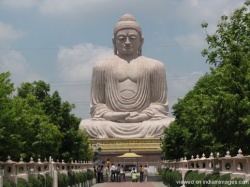Buddhist pilgrimage to Bodh Gaya as compared to other pilgrimages
I recently came back from a Buddhist pilgrimage to India and Nepal and saw all of the important places, the birth (Lumbini), enlightenment (Bodh Gaya), the first teaching (Sarnath), and the death-paranirvana (Kushinigar).
Noticeably the most important site in Buddhism is Bodh Gaya where the Buddha got enlightenment. The other sites were mostly ruins and did not have too many temples around them. But in Bodh Gaya there were many temples from many nations, many more tourists, and the beautiful Maha Bodhi temple complex where the Buddha attained enlightenment. The Maha Bodhi temple shown above was most likely originally built by King Ashoka in the 3rd century B.C. and rebuilt after warfare destruction in the 2nd century A.D. and subsequently repaired over the centuries up to the present time. It is 52 meters high (171 feet). There are also gardens, lakes, and a 24 meter (80 feet) Buddha statue in Bodh Gaya.
This shows that the holiest place in Buddhism (if there is such a thing) is Bodh Gaya. Pilgrimages are not too important in Buddhism because one can get enlightenment anywhere, but for those who wish to do this devotional and respectful practice, the Maha Bodhi complex in Bodh Gaya is clearly the most important place.
This gets me to reflect on the holy sites of all the different religions:
In Islam, the holiest place is Mecca, the birthplace of Mohammed. The religion is centered around the prophet Mohammed as he is considered the final prophet by many Muslims.
In Judaism, the holiest place is Jerusalem. The city of Jerusalem is the capitol of the ancient and modern nation of Israel. The religion of Judaism is centered on ideas that the Jewish people are both a faith and a people. Especially in Israel, the people see themselves as both a people and a religion.
In Christianity, a very holy place and pilgrimage site is also Jerusalem, but not for the above political reasons. Christians venerate Jerusalem as the place of Jesus' crucifixion. The Christian faith is centered around the death of Christ, believing that Christ rose from the dead in Jerusalem.
The clear contrast in Buddhism is that it is not the place of his birth, not the place of his death, but rather the place of enlightenment that is so important. Buddhism is a come and see religion with much effort required of each individual. We all must take the time to do study and practice, to attain insights. It is a hard work religion and this is why the enlightenment place is venerated most of all.
This is not to disparage or say that the other religions are bad or in any way lower, but it is just interesting to see the differences in the religions as to what they define as the most important pilgrimage site.
Even though one can achieve enlightenment anywhere, there is a recommendation by the Buddha for pilgrimage for those who can afford it and have the time to do so. From the parinibbana sutta, Digha Nikaya:
“Ananda, there are four places the sight of which will arouse strong emotion in those with faith. Which four? Here the Tathagata (enlightened one) was born, this is the first place. Here the Tathagata attained Enlightenment, this is the second place. Here the Tathagata set in motion the Wheel of the Dhamma, this is the third place. Here the Tathagata attained final Nibbana (Nirvana) without remainder, this is the fourth place. The monk or nun, layman or laywoman, who has faith should visit these places. And anyone who dies while making a pilgrimage to these places with a devout heart will, at the breaking up of the body, be reborn in heaven.”
Not too far from Bodh Gaya is Vulture Peak (elevation 2354 ft., 718 meters), where the Buddha often meditated. Most Buddhist pilgrims climb up Vulture Peak, whereas others take a motorized chair lift to the top. The stair climb up is roughly equivalent to 1500 steps.
